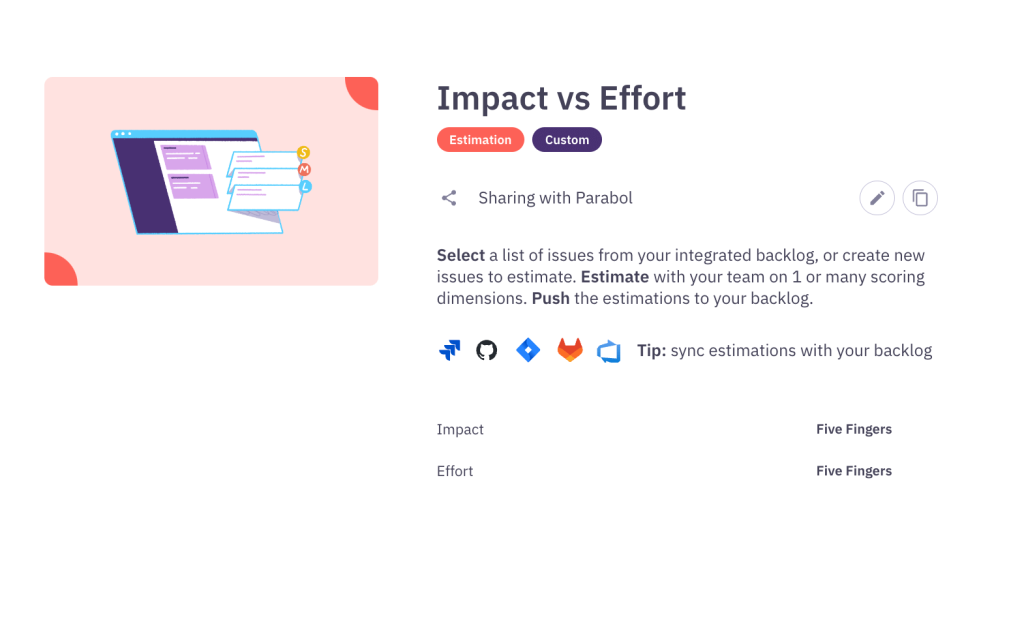Impact vs Effort Prioritization Template

What is Impact vs Effort prioritization
Impact vs Effort prioritization is a technique used to evaluate and prioritize tasks, projects, or features based on the balance between their potential impact and the effort required to implement them. It provides a structured approach for decision-making by considering the value a task brings (low impact or high impact) versus the resources and time needed to complete it (low effort or high effort).
Impact vs Effort is a simple prioritization method derived from the RICE prioritization framework, which looks at Reach and Confidence in addition to Impact and Effort.
How do you do Impact vs Effort prioritization?
There are two options for doing impact vs effort prioritization. We’ll take a look at both options and explain them so you can independently decide which one works best for you.
- Option 1: Scoring Approach
- Option 2: Matrix approach
Scoring approach to Impact vs Effort
When using the scoring approach, you will invite team members to independently score the impact and effort values on a scale of your choice. We recommend using a 1-5 scale, where 1 is low impact/high effort, and where 5 is high impact/low effort.
When you’ve ranked all your backlog items according to their impact and effort scores, you can simply add the numbers together. The highest impact and lowest effort tasks will have the highest scores, and the lowest impact highest effort tasks will have the lowest scores.
This gives you a prioritized list of items to execute on with clear numerical values.
Benefits of the scoring approach
We like this approach because it gives teams a clear prioritized list of tasks, project goals, or initiatives to execute on. Since product backlogs are usually in list form, it’s easy to transform your prioritization exercise into your product backlog.
If you are doing this activity as a group, everyone may have different scores. When there are numerical values, it’s possible to take an average of everyone’s scores and reach a better estimate of the relative importance of different items.
Matrix approach to Impact vs Effort
The Matrix approach involves creating a visual Impact vs Effort matrix in a brainstorming tool. Create your template in a brainstorming tool and drag each backlog item to the appropriate impact and effort level on the board.
This method does not use any scoring method, so it’s a purely visual indicator. You will have to do the work afterwards to order your items in your backlog tool. Nonetheless, using an impact effort matrix template allows you to clearly see your easy wins that require a small amount of effort and a small amount of time.
Benefits of the matrix approach
We like this approach for getting a general overview of how to prioritize items. We prefer the scoring method overall because it is more accurate, but the matrix approach has the key benefit of allowing teams to visualise items relative to each other. That’s hard to do with the scoring method.
When to use Impact vs Effort prioritization
Impact vs Effort is a versatile prioritization framework that can be used by product teams planning their roadmap, in project management, strategy discussions, or for anyone who wants a quick way to identify some low hanging fruit.
This method is a good option when you are not concerned with the Reach or Confidence of your tasks. With that in mind, Impact vs Effort is a good early stage and late stage prioritization rubric to help you gain clarity on what to tackle next.
How to use the Impact vs Effort prioritization template
Here’s a short overview of how to get started running a collaborative Impact vs Effort prioritization workshop in Parabol. You can run your meeting alone, or bring in any internal or external stakeholders to prioritize as a team.

- Open the Impact vs Effort prioritization template in Parabol, preferably ahead of any meeting you have planned so you can import all the items you want to prioritize.
- Import the items you want to prioritize from Jira, GitHub, or GitLab via integration, or add them in manually as Parabol tasks.
- Invite participants to join you in ranking items. In Parabol everyone can set their own Impact vs Effort ratings anonymously, and then you can compare and take an average.
- Schedule a call if you want to process and discuss trends together
- Independently rank items on their Impact vs Effort using a scale of your choice (we recommend 1-5).
- Reveal the results and discuss/compare rankings with your team-mates.
- Set final Impact vs Effort scores and optionally sync these scores automatically to your Jira, GitHub, or GitLab via Parabol’s two-way integration. Feel free to take an average score from your team for a more balanced prioritization approach.
- Walk away with a fully prioritized list. End the meeting and receive an email summary with your prioritized list of items.
Check out Parabol’s other prioritization templates including RICE prioritization and MoSCoW prioritization.